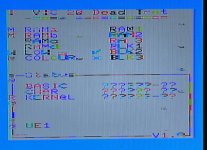CamiTheWitch
Member
So, I’m working on at least 3 VIC-20s at the moment, and all are in varying states of completely dead, and I’m hoping someone can help me find where to look.
Number 1 boots but the white background is black and the keyboard input is garbled. It loads a cartridge but the not fully. The one time it worked well enough for me to check, I confirmed it can display white, so something is telling it to display black on boot.
Number 2 boots to a fully garbage screen, and after about 10 seconds the colors get funky and the screen loses sync. I’m assuming that’s a VIC problem, but I’d be thrilled if it isn’t.
Number 3 booted to a garbage screen once, but now black screens. I’ve checked the 65245 chips of units 2 and 3 in my TL566II+ and they all test as good (1 has regular 74LS245s and they aren’t socketed).
Any help is appreciated, thanks!
Number 1 boots but the white background is black and the keyboard input is garbled. It loads a cartridge but the not fully. The one time it worked well enough for me to check, I confirmed it can display white, so something is telling it to display black on boot.
Number 2 boots to a fully garbage screen, and after about 10 seconds the colors get funky and the screen loses sync. I’m assuming that’s a VIC problem, but I’d be thrilled if it isn’t.
Number 3 booted to a garbage screen once, but now black screens. I’ve checked the 65245 chips of units 2 and 3 in my TL566II+ and they all test as good (1 has regular 74LS245s and they aren’t socketed).
Any help is appreciated, thanks!

